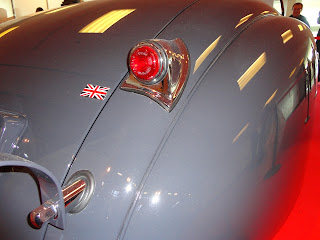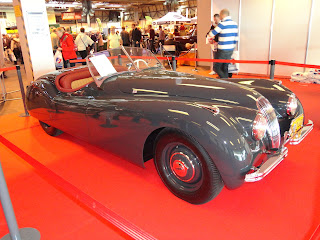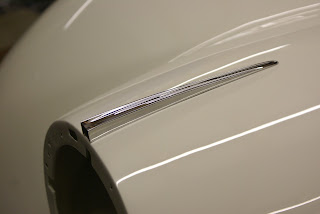Looking back, I had to say, as far as I could remember, probably never.
 |
| Aged about three. I am pretty sure that the Britool ring spanner in the picture is the same one I borrowed from my dad many years ago and still have and use. |
In 1961 I was 13 years old and a keen member, possibly even a founder member of the local track bike riders club. Not formally recognised as a club (not even by its members) it never the less had a quite definite set of rules and hierarchy. It was I think the same year that I distinguished myself by riding from home to school (about a mile) entirely on the back wheel of my very tatty old black bike. Also in that year, I remember that success in the 11 plus exam had rewarded a friend with a brand new Raleigh Blue Streak Racing Bike. A similar inducement from my parents had failed. I suppose somewhat piqued, I couldn't help but remind him that his pride and joy was named after a failed ballistic missile design.
With my new status as a teenager (just) it was obvious that something needed to be done to retain my perceived standing in the small community of Stokesley (as it was fifty years ago). It seemed to me that the measure of a man (boy) was mainly determined by his bike and to that end, my well worn old screeve (as bikes were then locally known) would need some serious attention.
The frame was duly stripped and re-painted with Humbrol black enamel. Cow-horn handlebars and knobbly tyres were purchased from Westbrookes Garage, and then the ultimate accessory – a new back wheel with Sturmey Archer all steel 3 speed ball bearing hub and 28 tooth cog, a special order from Place's bike shop. Total cost all in, about seven pounds. At two shillings and thrupence (11P) a day from my milk round (6.30 to 8.00am, 365 days a year) this equated to over two months wages, a big outlay. Life was hard... you know the rest. Anyway, all was well for a while. My re-furbished machine looked pretty good and performed very well on the various circuits around the towns beck-side but my slightly enhanced position in the pecking order was to be short lived. The local Blacksmiths son (another founder club member) had also been busy re-building his bike and I was given a preview.
Astonishment quickly turned to envy. It had front suspension. Now I know that the mountain bike fraternity generally believe that this development appeared around 25? years ago (no pedants please) but this 'son of a blacksmith' can lay claim to being a clear 20 or so years ahead of the game. Close scrutiny of the design revealed the following:
The front forks had been turned round. Telescopic tubes were fabricated from an old
bike frame, the cross bar removed then cut in half and neatly slid inside the
cut to length down tubes. The tubes were
squashed flat at the fixing ends and valve springs inserted down the larger
ones to effectively form a sprung tube. A
‘U’ shaped bracket had been made to hold the top of the spring tubes. This was fixed to the top of the forks with a
1/4 inch bolt where the front brake was previously attached. The scrap frames forks formed the swinging
arm which pivoted on the bikes reversed forks and held the wheel and the bottom
of spring tubes – Greaves / Dot style.
The front brake was now attached to the swinging arm forks. Damping would apparently be considered as the
next area for development.
In spite of my recent significant outlay, this new cycle technology really couldn't be ignored. Fortunately, in the early sixties almost every home had at least one old bike frame in the back garden, so I dashed (almost certainly on my back wheel) home to
my workshop (the wash house) and got to work with hack saw, hammer and hand
drill. A couple of days later the bike emerged with a close technical facsimile of the previously described front suspension, admittedly with some of the finer details omitted.Now for the trial ride. The first thing I noticed was that the front wheel seemed strangely disconnected from the handlebars. The suspension actually worked quite well but went up and down in unison with pedal strokes. My new found engineering acumen told me that wheelies (not a 1960’s term) would take a little more effort due to the additional weight of the re-constituted bike frame now attached to the front. Not to be put off, up went the front wheel, then gravity kicked in, the spring tubes parted company and the valve springs fell out and “boinged” down the road. Pedalling and balancing for a few seconds, I quickly acknowledged defeat and jumped off the back.
Re-assembly by the roadside was fairly straight forward and off we went again. The front brake was applied at the road end. Up went the swinging arm, (now attached via brake blocks to the wheel), and the entire assembly parted company again. Being approximately half my current weight and a little more agile, I once again landed more or less right side up. Becoming quite adept in the process of road side re-assembly, and considering myself on a par with aviation test pilots, undeterred I was off again in no time. So carefully avoiding wheelies and braking, how will it perform on some real bumps at speed. The engineers amongst you should be able to calculate the next critical path, but probably not the outcome. At the first bump, the 1/4 inch bolt holding the entire front suspension contrivance promptly snapped. The bottom of the stem tube landed on the knobbly tyre stopping the front of the bike instantly. The back of the bike (with me still attached) turned somersault as I shot over the handlebars. Unlike the previous two incidents, this one really hurt.
The bike (now the best part of 3 bikes) weighed quite a bit and the entire contraption now bounced up and down evenly in unison with pedal strokes. I have a wonderful memory of a group of racing cyclists slowing down to pass me, each one totally transfixed as I nonchalantly laboured in first gear up Seamer Hill, bum out of the saddle, the whole strange affair oscillating happily.
Many thanks to good friend and artist Pete Baker for the illustrations
Next serious post about 120 progress - beginning of January
























































